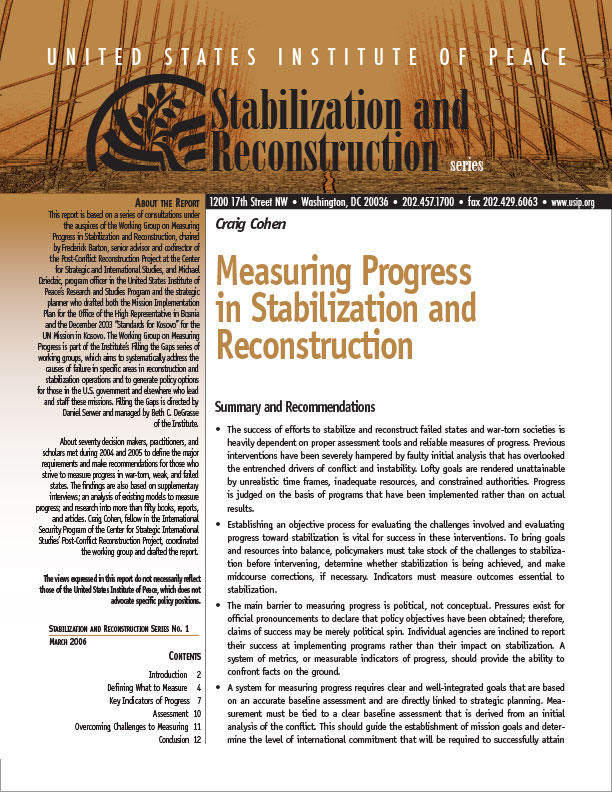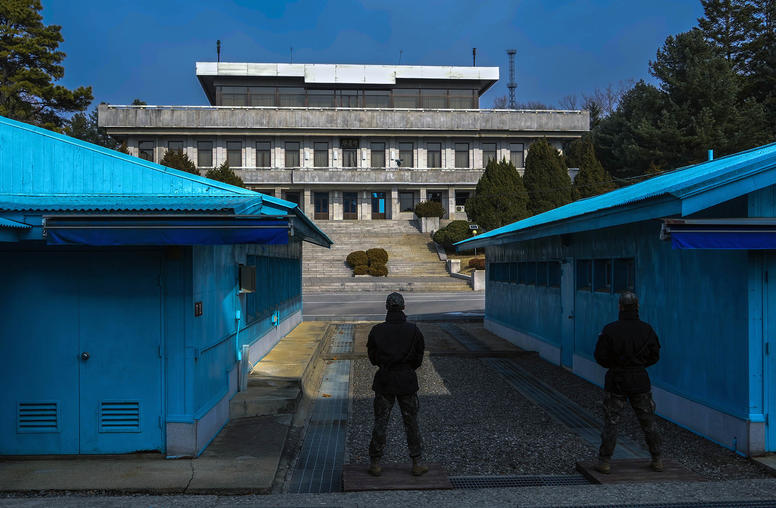Measuring Progress in Stabilization and Reconstruction
This report is based on series of consultations with the Working Group on Measuring Progress, a part of USIP's "Filling the Gaps" series which aims to systematically address the causes of failure in specific areas in reconstruction and stabilization operations and to generate policy options for those in the U.S. government and elsewhere who lead and staff these missions.

Summary and Recommendations
- The success of efforts to stabilize and reconstruct failed states and war-torn societies is heavily dependent on proper assessment tools and reliable measures of progress. Previous interventions have been severely hampered by faulty initial analysis that has overlooked the entrenched drivers of conflict and instability. Lofty goals are rendered unattainable by unrealistic time frames, inadequate resources, and constrained authorities. Progress is judged on the basis of programs that have been implemented rather than on actual results.
- Establishing an objective process for evaluating the challenges involved and evaluating progress toward stabilization is vital for success in these interventions. To bring goals and resources into balance, policymakers must take stock of the challenges to stabilization before intervening, determine whether stabilization is being achieved, and make midcourse corrections, if necessary. Indicators must measure outcomes essential to stabilization.
- The main barrier to measuring progress is political, not conceptual. Pressures exist for official pronouncements to declare that policy objectives have been obtained; therefore, claims of success may be merely political spin. Individual agencies are inclined to report their success at implementing programs rather than their impact on stabilization. A system of metrics, or measurable indicators of progress, should provide the ability to confront facts on the ground.
- A system for measuring progress requires clear and well-integrated goals that are based on an accurate baseline assessment and are directly linked to strategic planning. Measurement must be tied to a clear baseline assessment that is derived from an initial analysis of the conflict. This should guide the establishment of mission goals and determine the level of international commitment that will be required to successfully attain these goals. Measurement should be directly linked to planning and should integrate the various plans that are guiding the intervention.
- Progress in stabilization and reconstruction efforts should be based on the mission's ability to reduce the means and motivations for violent conflict in a society and to build local and state capacity to sustain peace. Progress should be measured in terms of outcomes. Indicators should focus on measuring outcomes or processes leading directly to these outcomes, as opposed to assessing the number of products and services delivered or the amount of resources consumed. Indicators should draw on an appropriate mix of data sources, including quantitative data and local perceptions.
- The following steps should be taken to build the U.S. government's measure progress in stabilization and reconstruction operations.
- The U.S. government should invest in developing the capacity to measure progress in all stabilization and reconstruction operations. This study presents a model that can be used to measure progress across vital areas of stabilization and reconstruction. It breaks the mission goal into core outcomes, central tasks, and measurable indicators that can be aggregated into numerical indexes or disaggregated according to geography, gender, or group identity.
This model constitutes a rudimentary framework for the development of a comprehensive metrics system for stabilization and reconstruction. Additional work is required to establish a fully articulated set of indicators that would provide the basis for initial baseline assessments and measures of progress for the core outcomes involved in stabilization and reconstruction. - Measures used to assess progress should be public and transparent, and the task of measuring should fall to a combination of independent external actors and an internal metrics office that is attached to mission planning. The metrics office should be empowered to solicit information from a variety of sources within the mission area and from international organizations involved in stabilization and reconstruction. It should be an integral component of strategic planning and its assessments should be used to inform the decisions of senior policymakers. External auditors should be brought in on a regular basis to work with the metrics office to perform independent assessments of progress to ensure objectivity.
- Decision makers must allocate adequate resources for assessing progress and integrate the results into their planning process. Resources earmarked specifically for measuring progress must be allocated from the initial assessment phase through the life of an intervention. Senior mission leaders must periodically review progress toward mission goals and take corrective action as required, otherwise the metrics process will quickly become an empty exercise.
- The U.S. government should invest in developing the capacity to measure progress in all stabilization and reconstruction operations. This study presents a model that can be used to measure progress across vital areas of stabilization and reconstruction. It breaks the mission goal into core outcomes, central tasks, and measurable indicators that can be aggregated into numerical indexes or disaggregated according to geography, gender, or group identity.
About the Report
This report is based on a series of consultations under the auspices of the Working Group on Measuring Progress in Stabilization and Reconstruction, chaired by Frederick Barton, senior advisor and codirector of the Post-Conflict Reconstruction Project at the Center for Strategic and International Studies, and Michael Dziedzic, senior program officer in the United States Institute of Peace's Center for Post-Conflict Peace and Stability Operations and the strategic planner who drafted both the Mission Implementation Plan for the Office of the High Representative in Bosnia and the December 2003 "Standards for Kosovo" for the UN Mission in Kosovo.
The Working Group on Measuring Progress is part of the USIP's Filling the Gaps series of working groups, which aims to systematically address the causes of failure in specific areas in reconstruction and stabilization operations and to generate policy options for those in the U.S. government and elsewhere who lead and staff these missions. Filling the Gaps is directed by Daniel Serwer and managed by Beth C. DeGrasse of the Institute.
About seventy decision makers, practitioners, and scholars met during 2004 and 2005 to define the major requirements and make recommendations for those who strive to measure progress in war-torn, weak, and failed states. The findings are also based on supplementary interviews; an analysis of existing models to measure progress; and research into more than fifty books, reports, and articles. Craig Cohen, fellow in the International Security Program of the Center for Strategic International Studies' Post-Conflict Reconstruction Project, coordinated the working group and drafted the report.
The views expressed in this report do not necessarily reflect views of the United States Institute of Peace, which does not advocate specific policy positions.





